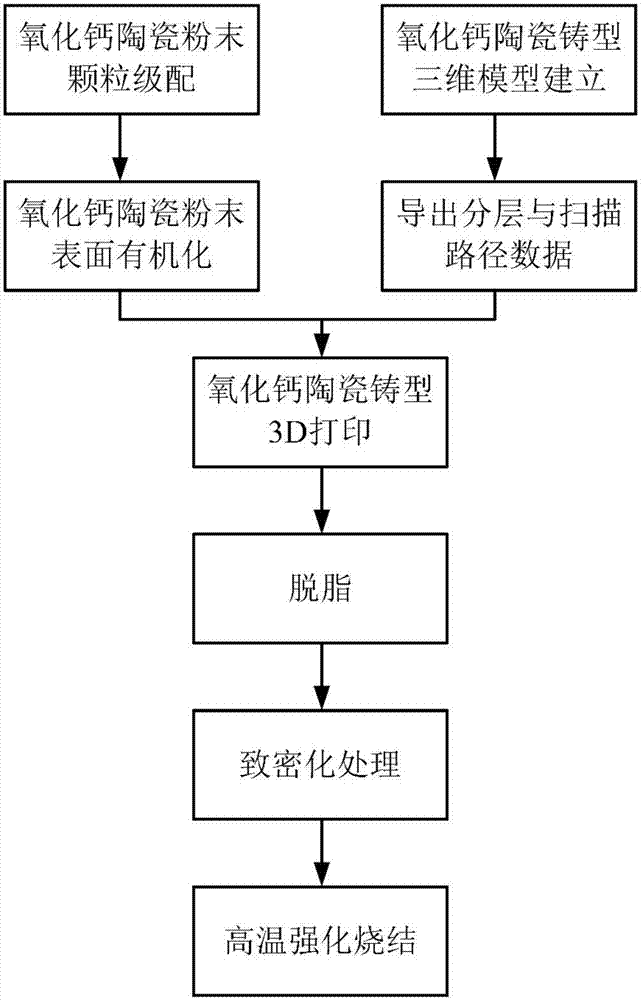Calcium oxide-based ceramic mold manufacturing method based on 3D (Three Dimensional) printing technology
A calcium oxide ceramic, calcium oxide-based technology, applied in the direction of additive processing, etc., can solve the problems of calcium oxide easy to absorb moisture and hydration, material design or manufacturing process is complicated, and increase the difficulty of calcium oxide-based ceramic casting mold manufacturing, etc., to achieve Solve the difficulty of core removal, promote sintering, and improve the effect of manufacturing yield
- Summary
- Abstract
- Description
- Claims
- Application Information
AI Technical Summary
Problems solved by technology
Method used
Image
Examples
Embodiment 1
[0033] 1) Select calcium oxide ceramic powders of 40 μm, 20 μm and 5 μm to carry out particle grading according to the mass ratio of 50:35:15 and mix them evenly;
[0034] 2) Carry out the surface organic treatment of the above-mentioned uniformly mixed powder, the specific operation is as follows:
[0035] (1) uniformly mixing the silane coupling agent with absolute ethanol to prepare an organic solution, the mass fraction of the silane coupling agent in the organic solution is 5%, and the mass fraction of absolute ethanol is 95%;
[0036] (2) fully and uniformly mixing the calcium oxide powder after particle grading with the organic solution at a mass ratio of 3:1 to prepare a mixed slurry;
[0037] (3) Put the mixed slurry at room temperature for 3 to 5 hours, then place it in a vacuum oven, and dry the powder completely to obtain calcium oxide ceramic powder with surface organic treatment;
[0038] 3) Add 5% mass fraction of nano-ZrO to the calcium oxide ceramic powder af...
Embodiment 2
[0046] Step 1, the calcium oxide ceramic powders of 40 μm, 20 μm and 5 μm are subjected to particle gradation and surface organic treatment according to the mass ratio of 50:35:15, and the surface organic treatment is to use Kh50 silane coupling agent as the raw material;
[0047] Step 2, uniformly mixing the silane coupling agent and absolute ethanol to prepare an organic solution, the mass fraction of the silane coupling agent in the organic solution is 5%, and the mass fraction of absolute ethanol is 95%;
[0048] Step 3, fully and uniformly mixing the calcium oxide powder that has completed particle grading and the organic solution at a mass ratio of 3:1 to prepare a mixed slurry;
[0049]Step 4, the mixed slurry is left to stand at room temperature for 3 hours, and then placed in a vacuum drying oven, and the surface organically treated calcium oxide ceramic powder is obtained after the powder is completely dried;
[0050] Step five, uniformly mix the organically treated ...
Embodiment 3
[0058] Step 1, the calcium oxide ceramic powders of 40 μm, 20 μm and 5 μm are subjected to particle gradation and surface organic treatment according to the mass ratio of 50:35:15, and the surface organic treatment is to use Kh50 silane coupling agent as the raw material;
[0059] Step 2, uniformly mixing the silane coupling agent and absolute ethanol to prepare an organic solution, the mass fraction of the silane coupling agent in the organic solution is 5%, and the mass fraction of absolute ethanol is 95%;
[0060] Step 3, fully and uniformly mixing the calcium oxide powder that has completed particle grading and the organic solution at a mass ratio of 3:1 to prepare a mixed slurry;
[0061] Step 4, the mixed slurry is left to stand at room temperature for 5 hours, and then placed in a vacuum drying oven, and the surface organically treated calcium oxide ceramic powder is obtained after the powder is completely dried;
[0062] Step 5, uniformly mix the organically treated ca...
PUM
| Property | Measurement | Unit |
|---|---|---|
| particle size | aaaaa | aaaaa |
| length | aaaaa | aaaaa |
| service temperature | aaaaa | aaaaa |
Abstract
Description
Claims
Application Information
 Login to View More
Login to View More - R&D
- Intellectual Property
- Life Sciences
- Materials
- Tech Scout
- Unparalleled Data Quality
- Higher Quality Content
- 60% Fewer Hallucinations
Browse by: Latest US Patents, China's latest patents, Technical Efficacy Thesaurus, Application Domain, Technology Topic, Popular Technical Reports.
© 2025 PatSnap. All rights reserved.Legal|Privacy policy|Modern Slavery Act Transparency Statement|Sitemap|About US| Contact US: help@patsnap.com

